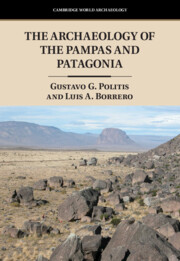Book contents
- The Archaeology of the Pampas and Patagonia
- Cambridge World Archaeology
- The Archaeology of the Pampas and Patagonia
- Copyright page
- Dedication
- Contents
- Acknowledgments
- Chapter 1 Introduction
- Chapter 2 Historical Background
- Chapter 3 Resources: Prey, Plants, and Stones
- Chapter 4 The Early Peopling: The Late Pleistocene to Early Holocene
- Chapter 5 The Middle Holocene (~ 8200–4200 cal BP; ~ 7500–3800 BP)
- Chapter 6 The Late Holocene Diversification (~ 4200 cal BP to ~ 400 cal BP; ~ 3800 BP to ~ 400 BP)
- Chapter 7 Final Remarks
- Select Bibliography
- Index
Chapter 3 - Resources: Prey, Plants, and Stones
Published online by Cambridge University Press: 14 February 2024
- The Archaeology of the Pampas and Patagonia
- Cambridge World Archaeology
- The Archaeology of the Pampas and Patagonia
- Copyright page
- Dedication
- Contents
- Acknowledgments
- Chapter 1 Introduction
- Chapter 2 Historical Background
- Chapter 3 Resources: Prey, Plants, and Stones
- Chapter 4 The Early Peopling: The Late Pleistocene to Early Holocene
- Chapter 5 The Middle Holocene (~ 8200–4200 cal BP; ~ 7500–3800 BP)
- Chapter 6 The Late Holocene Diversification (~ 4200 cal BP to ~ 400 cal BP; ~ 3800 BP to ~ 400 BP)
- Chapter 7 Final Remarks
- Select Bibliography
- Index
Summary
Since cultivation was late and marginal and there were no domestic animals (except the dog) in the Pampas and Patagonia, indigenous people in both regions depended almost exclusively on wild animals, both terrestrial and aquatic, and undomesticated plants. At the same time, stones were also crucial for making the tools to kill and butcher the prey and to process the plant products. As we will show, bone technology was secondary in most of the Pampas and significant only among coastal, both maritime and riverine, and Paraná Delta people. Therefore, wild natural resources were the key elements for human subsistence in the Pampas and Patagonian and, in some way, shaped their adaptive patterns.
- Type
- Chapter
- Information
- The Archaeology of the Pampas and Patagonia , pp. 67 - 114Publisher: Cambridge University PressPrint publication year: 2024

